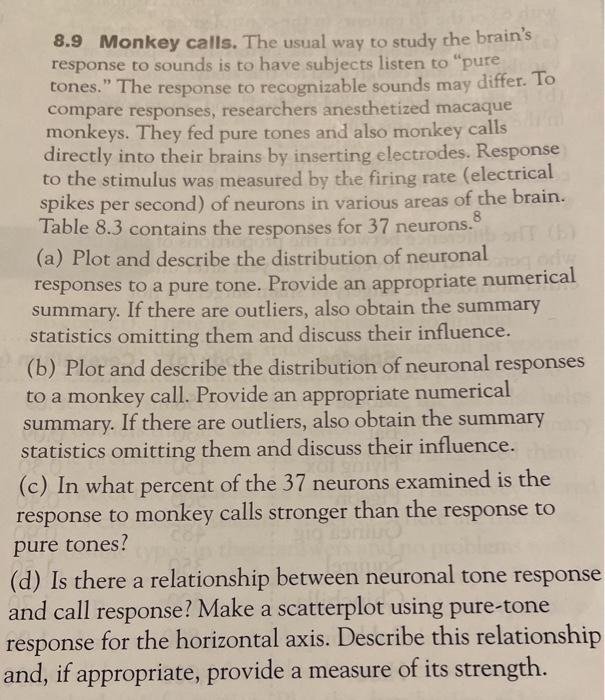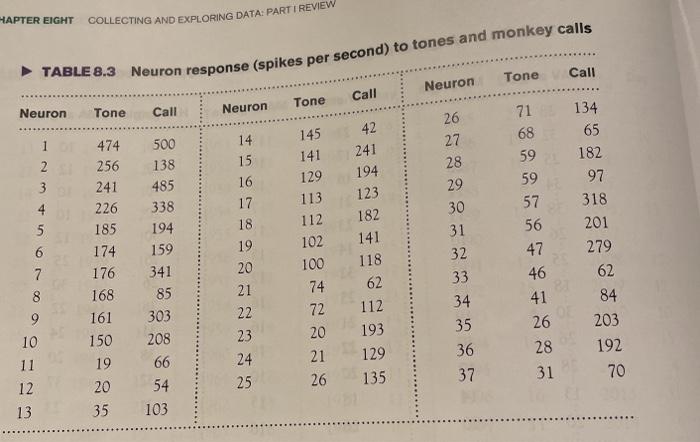Answered step by step
Verified Expert Solution
Question
1 Approved Answer
the program is R 8.9 Monkey calls. The usual way to study the brain's response to sounds is to have subjects listen to pure tones.


the program is R
8.9 Monkey calls. The usual way to study the brain's response to sounds is to have subjects listen to "pure tones." The response to recognizable sounds may differ. To compare responses, researchers anesthetized macaque monkeys. They fed pure tones and also monkey calls directly into their brains by inserting electrodes. Response to the stimulus was measured by the firing rate (electrical spikes per second) of neurons in various areas of the brain. Table 8.3 contains the responses for 37 neurons. (a) Plot and describe the distribution of neuronal responses to a pure tone. Provide an appropriate numerical summary. If there are outliers, also obtain the summary statistics omitting them and discuss their influence. (b) Plot and describe the distribution of neuronal responses to a monkey call. Provide an appropriate numerical summary. If there are outliers, also obtain the summary statistics omitting them and discuss their influence. (c) In what percent of the 37 neurons examined is the response to monkey calls stronger than the response to pure tones? (d) Is there a relationship between neuronal tone response and call response? Make a scatterplot using pure-tone response for the horizontal axis. Describe this relationship and, if appropriate, provide a measure of its strength. HAPTER EIGHT COLLECTING AND EXPLORING DATA: PARTI REVIEW TABLE 8.3 Neuron response (spikes per second) to tones and monkey calls Tone Call Neuron Call Tone Neuron Tone Call Neuron 1 56 3 4 5 6 7 8 9 474 256 241 226 185 174 176 168 161 150 19 20 35 500 138 485 338 194 159 341 85 303 208 14 15 16 17 18 19 20 21 22 23 24 25 145 42 141 241 129 194 113 123 112 182 102 141 118 62 112 193 129 135 26 71 134 27 68 65 28 59 182 29 59 97 30 57 318 31 201 32 47 279 33 46 62 34 41 84 35 26 203 36 28 192 37 31 70 100 74 72 20 21 26 10 66 11 12 13 54 103 8.9 Monkey calls. The usual way to study the brain's response to sounds is to have subjects listen to "pure tones." The response to recognizable sounds may differ. To compare responses, researchers anesthetized macaque monkeys. They fed pure tones and also monkey calls directly into their brains by inserting electrodes. Response to the stimulus was measured by the firing rate (electrical spikes per second) of neurons in various areas of the brain. Table 8.3 contains the responses for 37 neurons. (a) Plot and describe the distribution of neuronal responses to a pure tone. Provide an appropriate numerical summary. If there are outliers, also obtain the summary statistics omitting them and discuss their influence. (b) Plot and describe the distribution of neuronal responses to a monkey call. Provide an appropriate numerical summary. If there are outliers, also obtain the summary statistics omitting them and discuss their influence. (c) In what percent of the 37 neurons examined is the response to monkey calls stronger than the response to pure tones? (d) Is there a relationship between neuronal tone response and call response? Make a scatterplot using pure-tone response for the horizontal axis. Describe this relationship and, if appropriate, provide a measure of its strength. HAPTER EIGHT COLLECTING AND EXPLORING DATA: PARTI REVIEW TABLE 8.3 Neuron response (spikes per second) to tones and monkey calls Tone Call Neuron Call Tone Neuron Tone Call Neuron 1 56 3 4 5 6 7 8 9 474 256 241 226 185 174 176 168 161 150 19 20 35 500 138 485 338 194 159 341 85 303 208 14 15 16 17 18 19 20 21 22 23 24 25 145 42 141 241 129 194 113 123 112 182 102 141 118 62 112 193 129 135 26 71 134 27 68 65 28 59 182 29 59 97 30 57 318 31 201 32 47 279 33 46 62 34 41 84 35 26 203 36 28 192 37 31 70 100 74 72 20 21 26 10 66 11 12 13 54 103 Step by Step Solution
There are 3 Steps involved in it
Step: 1

Get Instant Access to Expert-Tailored Solutions
See step-by-step solutions with expert insights and AI powered tools for academic success
Step: 2

Step: 3

Ace Your Homework with AI
Get the answers you need in no time with our AI-driven, step-by-step assistance
Get Started


